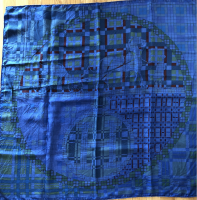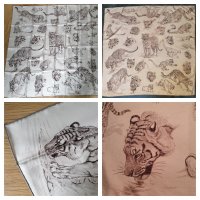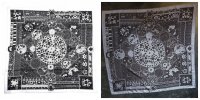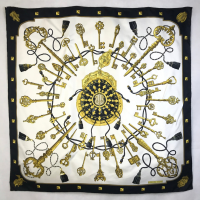Sure, no problem. Grab a drink or snack because long post ahead...

I used the Dylon washing machine dye...this is not the dye for silks and they say it won't dye wool and silk...who am I to actually pay attention to instructions?

I actually believe that they state that because most silk articles are dry clean only. But H scarves can be washed in the machine, even though they state not to do it, so I felt OK trying it. If you are nervous, use the hand dye method. Note this is the new "pod" style Dylon that doesn't require salt. Note also that the scarf is a 140 silk twill.
Throughout I used the 30 degree setting (cold in the US). In any case, the Dylon washing machine dyes are now able to work at this low setting (in the past it had to be 60+). If you are somewhere where Dylon isn't available, I can't speak to what would be a dupe.
Step 1. Wash scarf. I first did a short wash (20-30m) with a woolite type detergent meant for wools/silks. This is important. Some H scarves have an coating on them that make them stiffer and you want to make sure the dye job comes out uniform. Also, sweat, etc. on a scarf post wear will then be removed, anything that's been rubbed onto it, etc. If it is clean, it'll absorb dye evenly. Instructions state to start with a wet article, so I washed the scarf and that's it. No fabric softener, nothing. Just detergent. After this cycle completed I moved to step 2.
Step 2. As per the Dylon instructions, I put the pod on top of the to be dyed scarf. Here's the caveat, and here's where you need to use your judgment. A pod can color 600g of fabric full color, 1.2kg in a lighter color. They usually base this on cotton. Silk will soak up less dye than cotton would. So it'll turn out lighter, regardless. There is a lot of dye in the pod (already premixed with salt). I was worried about it coming out too dark but didn't want to fiddle with only using half the dye, etc. because this was my first attempt. Regardless, I ran a "shorter" wash - I started with a pre set for 1 hr at 30 degrees C with no intent to let the cycle go longer than 45m but wanted room to to shorten as necessary. Note as well, I put in another large scarf in to help "sop up" some of the dye. Was it necessary? Likely not. After about 15 minutes, I could see the scarf through the window of the machine and felt it was quite dark (remember it will lighten post rinse and rewash and once dry). At about 20-25 minutes I decided to stop the main wash and let the machine do a rinse/centrifuge.
Step 3. Run a final wash with detergent (woolite type again) and this time I added fabric softener (not necessary but I wanted a soft scarf). I ran a cold delicates wash, which is roughly 45 minutes long on my machine. The only difference between this setting and the shorter one in step 2 is the centrifuge strength. To be honest, I was surprised because the first and second steps I did at the highest centrifuge setting. Dumb move? I don't know...but my scarf is just fine. I am surprised at how strong silk is (this is the twill, again).
Then I just dried by rolling in a towel. I luckily didn't need to even iron because it was completely wrinkle free post roll once dry. And that's that.
I will admit to being INCREDIBLY nervous as I had never done this before. I ate 2 pints of ice cream during the process.

But really the worst that could happen was that it didn't turn out well. And I wasn't wearing it anyway. I figured if the color was rubbish I could always try to do another attempt with another color but thankfully didn't have to.
Hope this long post helps...if anyone else tries this, I'd love to see the results.
By the way, the other large scarf I threw in together with the H scarf was a 140 cashmere silk mix (not H) that I didn't like and I wouldn't have minded losing. It survived, is evenly dyed but it is not nice. It got all nubby. So don't do this with your cashmere mixes! Stick to the silk twills. Oh, and after you do the final step, run a wash in your machine at the highest setting without anything in it just to make sure all the dye is gone so that your next laundry load is not destroyed

...just to make sure, the first load that'll go in there will consist of black clothes only!
Hope this helps





 I actually believe that they state that because most silk articles are dry clean only. But H scarves can be washed in the machine, even though they state not to do it, so I felt OK trying it. If you are nervous, use the hand dye method. Note this is the new "pod" style Dylon that doesn't require salt. Note also that the scarf is a 140 silk twill.
I actually believe that they state that because most silk articles are dry clean only. But H scarves can be washed in the machine, even though they state not to do it, so I felt OK trying it. If you are nervous, use the hand dye method. Note this is the new "pod" style Dylon that doesn't require salt. Note also that the scarf is a 140 silk twill. But really the worst that could happen was that it didn't turn out well. And I wasn't wearing it anyway. I figured if the color was rubbish I could always try to do another attempt with another color but thankfully didn't have to.
But really the worst that could happen was that it didn't turn out well. And I wasn't wearing it anyway. I figured if the color was rubbish I could always try to do another attempt with another color but thankfully didn't have to.



